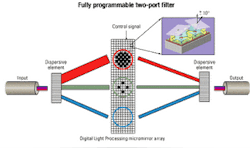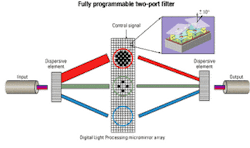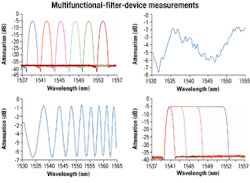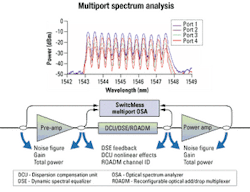Multifunctionality the key in challenging instrumentation markets
The demise of the telecommunications market has produced two challenging forces affecting manufacturers of test and measurement (T&M) and laboratory instrumentation. Capital-expenditure (capex) cutbacks by the carriers have led to a proportional slowdown in the installation side of the T&M market. The same capex reductions have also accelerated the attrition of telecom startup companies, which has further accelerated the drop in instrument demand from year 2000 levels. Thus, the instrumentation and T&M spaces are now suffering from an oversupply not only from vendors, but also from the gray markets where many used products are being sold at as much as a 90% discount. This combination presents one of the more challenging scenarios for introducing new products into the marketplace.
New products can succeed in this environment if they offer unquestionably new and flexible functionality at attractive prices, making the value proposition difficult to ignore. For example, free-space optics, used alone or in combination with digital micro-electromechnical systems (MEMS), offers the proverbial "more with less" functionality to spectral base instrumentation. One example of the technologies just now coming available is a single optical instrumentation platform that via software control can be a spectrum analyzer; a bandpass, low-pass, or high-pass filter; a WDM system simulator; a Gaussian broadband source; or any other spectrally shaped source. A single optical engine capable of simultaneously performing optical spectrum analysis of any number of optical inputs, determined again by software control, is another example of innovations that have occurred over the last few years. Such technologies will form the core of successful products in the next few years.
Optical component and module manufacturers often complain about the large array of specialized and expensive optical T&M equipment required on manufacturing lines. The complaints stem from added complexity to the line, increased potential for obsolescence and downtime, and the challenge of an attractive return on capital investment.
An effective counter-strategy is to use instruments that can perform many functions and therefore offer intrinsic redundancy and flexibility as well as address the potential for future changes to the manufacturing line. True multifunctionality is not achieved by packaging many expensive modules into an instrumentation rack. Instead, it is obtained by using a single optical engine capable of being configured via software to perform the functions of different instruments.
Digital MEMS technology based on the Texas Instruments Digital Light Processing* architecture can make such configurable instrumentation possible. The TI Digital Micromirror Device (DMD), already used in the projection, television, cinema, and other display markets, is a single integrated device with roughly 800,000 individually controllable micromirrors on a single ~1-inch2 chip. These mirrors can be tilted in either +10- or -10-degree states through digital commands.The instrument used to generate the data in Figure 2 has a wavelength resolution of 120 pm and an optical impulse response function with a 400-pm, 3-dB bandwidth. The low chromatic dispersion, multipath interference, and polarization-dependent loss intrinsic to the DMD and optical design are compatible with applications involving 10- and 40-Gbit/sec transmission systems.
The selection of dynamic filters produced by the programmable spectral filter shown in Figure 2 provides a glimpse into the versatility of this technology. Among the possibilities shown is a tunable bandpass filter and a variable bandwidth filter usable in channel- and band-drop and/or bit-error-rate testing applications. Also shown is a chirped sinusoidal filter usable for component testing and a completely arbitrary spectral transmission function used for channel power balancing, pre-emphasis, or gain-flattening applications. The same instrument can be used to interleave, block, attenuate, and multiplex channels. All these functions are created through software control in a 200-msec time frame, which makes the technology ideal for time-sharing within, or among, manufacturing cells. The flexibility and rapid response can also be leveraged to speed installation and maintenance procedures.
In keeping with the high-value proposition theme of flexible and configurable test solutions, the programmable spectral filter can be teamed with internal optical sources to produce an equally flexible light generation instrument. This flexibility can be used to produce spectrally flat sources (see Figure 3) that ease component testing, simulate different amplified spontaneous emission (ASE) profiles for gain-flattening-filter testing, and simulate WDM transmission systems.WDM simulation is a good example of where a single instrument can provide a more capable solution for a lower overall cost and yet avoid the trap of purchasing special-purpose instrumentation. Current WDM simulators serialize interleavers or Fabry-Perot cavities with ASE sources to produce a series of channels with a fixed predefined spacing. These simulators cannot control power and noise of individual channels, which is often required when testing optical-channel monitors, amplifiers, add/drop multiplexers (ADMs), and other optical subsystems sensitive to optical-signal-to-noise ratio.
In contrast, programmable broadband sources enable WDM simulation with user control over the channel spacing, the presence of channels (e.g., to simulate channel drops), and individual channel power and noise power (see Figure 3).
The value proposition of the programmable sources and filters described above stems from the flexibility and multifunctionality embedded in a single two-port instrument. While these functions are achieved by introducing a new class of instrumentation based on MEMS technology, the same type of value proposition is possible with more traditional classes of T&M equipment based on more established optical engines.
Optical spectrum analyzers (OSAs) are one example. Considered expensive yet indispensable, these instruments have seen little innovation over the past two decades. It is not unusual to see one or two OSAs per component or subsystem manufacturing workstation. At prices ranging from $20,000 for stripped down OSAs to $60,000 for full-function benchtop instruments, OSAs represent a significant expense for all photonic-system manufacturers. The cost in itself is a significant barrier to sales even in the best economic environments, but OSA suppliers have suffered from a disproportionately large and thriving gray market. All these factors place even greater stress on already depressed OSA sales.
Taking advantage of parallel optical processing in free-space optics spectrometer designs, it is now possible to develop single OSAs capable of simultaneously measuring spectra from multiple input fibers. These multiport OSAs allow cost amortization over multiple tests within or among manufacturing cells.
Multiport OSAs obviously can be accomplished by serializing a multiport optical switch with an OSA but at the expense of additional uncertainty in power accuracy, spectral characteristics, and added delay between measurements. Adding delay means that manufacturing cells cannot operate independently, which has the negative impact of disrupting manufacturing workflow. Avoiding this type of disruption is the reason manufacturing cells often absorb the expense of individual OSAs.
An OSA that uses a single optical engine to simultaneously and independently interrogate multiple fibers makes timesharing OSAs feasible. Because optical parallel processing uses the same optical engine to measure spectra from different fibers, the multiport OSA cost structure is essentially the same as traditional single-port OSA solutions.
Installation and maintenance applications have even more compelling reasons for requiring simultaneous spectral measurements from different measurement points. For example, it is important to measure channel spectra entering and exiting inline amplifiers (ILAs), dispersion compensation units, reconfigurable optical ADMs, and/or dynamic gain equalizers to quickly measure and validate subsystem performance. Figure 4 shows an application where a four-port OSA based on parallel optical processing was used to measure the spectrum at four access ports of an ILA. Though four-port OSAs are a couple of years away from commercialization, two-port instruments should be available by the end of this year.High-value, multifunctional instruments have been under development for several years, but they have seen limited deployment for several reasons. During the boom years culminating in 2000, there was little incentive for the major incumbents to introduce new technologies when they were finding it difficult to meet demand for existing products. As the market contracted, incumbents began to focus internally on restructuring and private companies focused on survivability. Fortunately, innovation is the natural consequence of increasing competition and price pressure, so new technologies with undeniable value propositions are sure to emerge.
While the focus here is on a specific set of emerging spectral filtering and characterization technologies, other examples are emerging in multifunctional measurements (combined polarization-dependent loss, dispersion, and polarization-mode dispersion measurements) and impairment simulation. The very market forces making the test and measurement space so challenging are indirectly fueling many of these advances. Tunable photonics technologies developed for next-generation networks are now searching for alternative market outlets and finding them in the T&M space. The challenge for multifunction instrumentation suppliers will be to define this new class of equipment in a way that conveys their flexibility and power and engenders adoption over more traditional solutions.
Dr. Jim Sirkis is vice president of network and instrumentation products at CiDRA Corp. (Wallingford, CT). He can be reached at [email protected].
*Digital Light Processing is a trademark of Texas Instruments.




